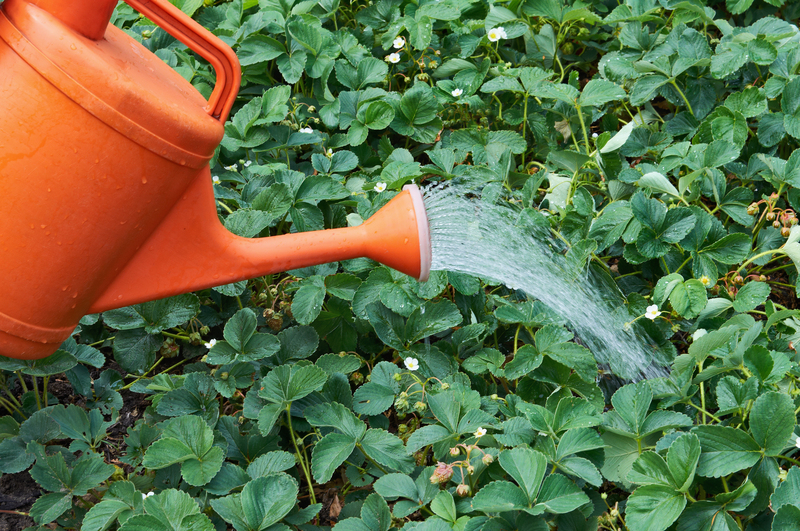Discovering Eco-Gardening's Role in Climate Resilience
Posted on 07/09/2025
Discovering Eco-Gardening's Role in Climate Resilience
Climate change is increasingly shaping the way we live, grow, and interact with our natural surroundings. As storms intensify, droughts stretch, and temperature extremes become the norm, one movement at the intersection of environmental stewardship and home landscapes is taking root: eco-gardening. But what does this sustainable gardening practice mean for our ongoing battle against climate uncertainty? In this comprehensive article, we delve deep into eco-gardening's pivotal role in climate resilience, examining its benefits, methods, and real-world impact for individuals and communities alike.

What Is Eco-Gardening and Why Does It Matter for Climate Resilience?
Eco-gardening, also known as ecological or sustainable gardening, is an approach that prioritizes environmental harmony, biodiversity, and resource efficiency. Unlike traditional gardening approaches, it focuses on working with nature rather than against it. This not only nurtures healthy plants but also bolsters local ecosystems against the unpredictable effects of climate change.
- Promotes biodiversity by planting diverse species and attracting beneficial insects
- Emphasizes water conservation through rain gardens, mulching, and efficient irrigation
- Reduces carbon footprint via organic practices and local food production
- Increases soil health using composting and reduced chemical inputs
- Improves microclimates for urban and rural environments alike
These attributes make eco-gardening a critical ally in building climate resilience both at home and in the larger landscape.
The Intersection of Eco-Gardening and Climate Resilient Landscapes
Understanding Climate Resilience
Climate resilience refers to the ability of systems--natural or human--to anticipate, prepare for, and adapt to changing climatic conditions. For gardeners and land managers, this means adopting practices that not only survive extremes but thrive amid them.
How Eco-Gardening Fosters Climate Adaptation
Eco-gardening significantly enhances a garden's ability to withstand and recover from climate-driven stresses. Here are several ways it does so:
- Native Plantings: Native species are adapted to local conditions, making them more drought-tolerant and pest-resistant.
- Soil Regeneration: Using organic matter and avoiding chemicals fosters rich, resilient soils that absorb and retain water more efficiently.
- Poly-cultures: Diverse plantings help deter pests, reduce disease, and buffer against crop failure due to unpredictable weather.
- Minimal Disturbance: Methods like no-dig gardening reduce soil erosion and strengthen soil structure.
By weaving these sustainable gardening techniques into your outdoor space, you not only create a beautiful and productive garden but also an ecological stronghold against the challenges of a changing climate.
Key Eco-Gardening Strategies for Building Climate Resilience
Let's dive deeper into the most effective eco-gardening practices that directly bolster climate adaptation and landscape resilience:
1. Water Conservation and Management
With water scarcity becoming a hallmark of climate change, efficient use and management of water resources is fundamental.
- Rain gardens capture and filter stormwater, reducing runoff and recharging groundwater supplies.
- Drip irrigation systems deliver water directly to roots, minimizing waste through evaporation.
- Mulching conserves soil moisture, suppresses weeds, and protects plant roots from temperature extremes.
- Greywater recycling reuses water from baths, sinks, or washing machines for non-edible plants.
2. Soil Health and Carbon Sequestration
Healthy soils are living systems essential for carbon storage and water retention, both of which are crucial for climate resilience.
- Composting organic waste returns nutrients to the soil and reduces greenhouse gas emissions from landfills.
- Cover cropping and green manures increase organic matter, prevent erosion, and enhance fertility.
- No-till practices protect soil wildlife, structure, and carbon stores while reducing fuel use.
3. Biodiversity Enhancement
Biodiversity is a key buffer against environmental shock.
- Planting a variety of species encourages beneficial predators and pollinators.
- Creating insect hotels and wildflower strips supports birds, bats, bees, and butterflies.
- Habitat restoration (ponds, log piles) fosters a rich tapestry of micro-environments.
4. Agroecological Approaches and Edible Landscaping
Blending food production with eco-gardening practices creates abundant and resilient urban farms and edible gardens.
- Polycultures and companion planting reduce the need for pesticides and chemical fertilizers.
- Perennial crops require less water, fertilizer, and maintenance over annuals.
- Agroforestry incorporates trees and shrubs into gardens for shade, soil enhancement, and carbon sinks.
5. Low-Impact Design and Material Use
Sustainable material choices reduce environmental impact and support long-term resilience.
- Recycled or upcycled garden structures minimize waste and extend resource life-cycles.
- Natural fencing, such as living hedges, provide windbreaks and shelter wildlife.
- Permeable paving allows rainwater infiltration, reducing flooding and overheating in urban areas.
Eco-Gardening in Different Climates: Tailoring Strategies for Maximum Resilience
One of the most remarkable aspects of eco-gardening's role in climate resilience is its adaptability to varying climates and regional challenges.
Eco-Gardening in Arid and Drought-Prone Areas
- Drought-tolerant native plants, such as succulents and wildflowers, require less water.
- Mulch and ground cover protect soil from evaporation.
- Efficient irrigation and water storage methods are prioritized.
Eco-Gardening in Flood-Prone Regions
- Rain gardens absorb and filter excess stormwater.
- Water-loving tree species stabilize soils and mitigate runoff.
- Building raised beds prevents crop loss from waterlogging.
Cold and Mountainous Climates
- Utilizing thermal mass (rocks, walls) retains warmth for frost-sensitive plants.
- Planting windbreaks minimizes temperature extremes.
- Season-extending structures, such as cold frames and greenhouses, lengthen the growing season.
The Benefits of Eco-Gardening for Individuals and Communities
1. Food Security and Self-Sufficiency
Growing your own food reduces reliance on supply chains vulnerable to climate disruption.
- A diversity of crops increases harvest reliability, providing sustenance during difficult periods.
- Urban eco-gardening initiatives turn vacant land into productive edible landscapes, fighting food deserts.
2. Climate Mitigation and Environmental Health
Eco-gardening not only adapts to climate change but also helps mitigate its causes.
- Organic methods limit the release of greenhouse gases and chemical runoff.
- Trees and healthy soils sequester carbon, directly offsetting emissions.
- Garden green spaces cool urban environments and cleanse pollutants from air and water.
3. Emotional and Community Well-Being
- Eco-gardening fosters a connection to nature, reducing anxiety about climate change and creating purpose.
- Community gardens build resilience at a neighborhood level through collective education and action.
- Shared knowledge and seeds strengthen cultural heritage and resource sharing.
Real-World Examples: Eco-Gardening Driving Local Climate Resilience
Across the globe, individuals and organizations are harnessing eco-gardening to build climate resilience in creative and powerful ways:
- Permaculture projects in Australia have turned degraded plots into lush, food-productive oases with minimal water input.
- Rain garden programs in U.S. cities have reduced urban flooding and recharged groundwater supplies.
- Community agroecology networks in Latin America have restored deforested areas and improved food sovereignty.
- Rewilding initiatives across Europe are boosting pollinator numbers and creating resilient wildlife corridors.
How to Start Your Climate-Resilient Eco-Garden
Ready to make a difference in your own backyard? Here's a step-by-step checklist for initiating your own eco-garden with climate resilience in mind:
- Observe your site: Assess sunlight, water movement, soil health, and wind patterns.
- Choose native and climate-adapted plants: Select varieties best suited to your region's conditions.
- Practice soil stewardship: Use organic amendments and mulch for healthy, living soil.
- Collect and conserve water: Install rain barrels, drip irrigation, and create drought strategies.
- Encourage biodiversity: Add flowering plants, habitats, and avoid synthetic chemicals.
- Plan for extremes: Develop solutions for both drought and flood scenarios, such as raised beds and rain gardens.
- Engage your community: Share seeds, skills, and stories to foster a resilient network.

The Future of Eco-Gardening in Climate-Resilient Societies
As climate pressures mount, the fusion of eco-gardening and climate resilience will no longer be a niche interest--it will be essential. Municipal planners, educators, homeowners, and farmers all have a vital role to play in remaking our landscapes for a changing world.
Eco-gardening provides a hopeful, hands-on path toward thriving, sustainable, and adaptable communities--one garden at a time. As more people embrace these principles, we'll collectively grow a future where people and nature flourish together, no matter what climate changes may bring.
Conclusion: Growing Strong in the Face of Change
In summary, eco-gardening's role in climate resilience cannot be understated. Its foundation of biodiversity, water wisdom, soil health, and community spirit enables both small and large landscapes to weather the storms, droughts, and disruptions of our times. Embracing eco-gardening is an empowered and optimistic response--one that combines beauty, sustenance, and hope.
Whether you are a seasoned horticulturist or a beginner dreaming of a greener tomorrow, now is the time to discover the powerful role of eco-gardening in building a climate-resilient future. Start where you are, plant what you can, and watch as resilience takes root and grows.

